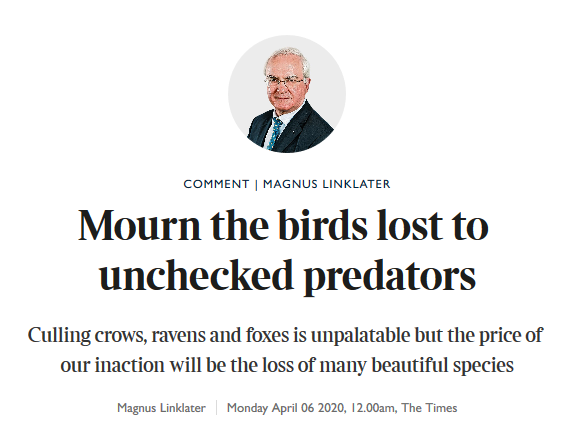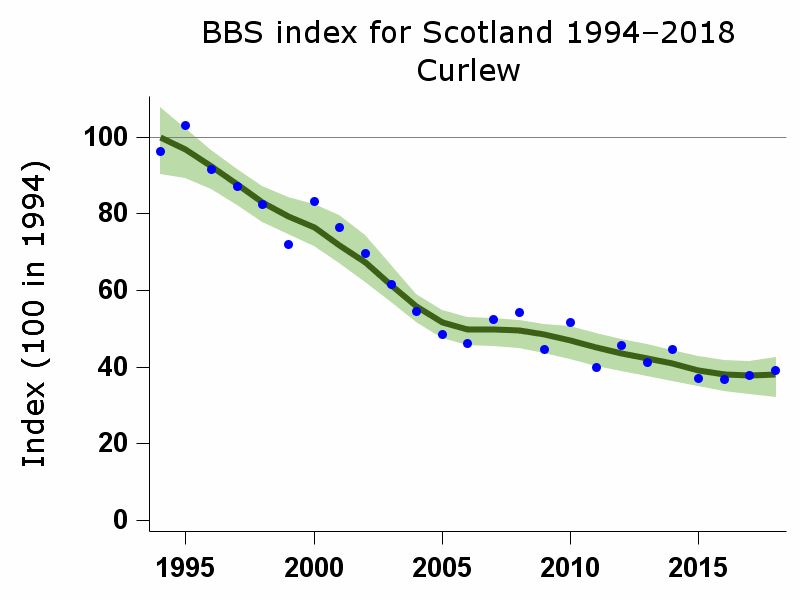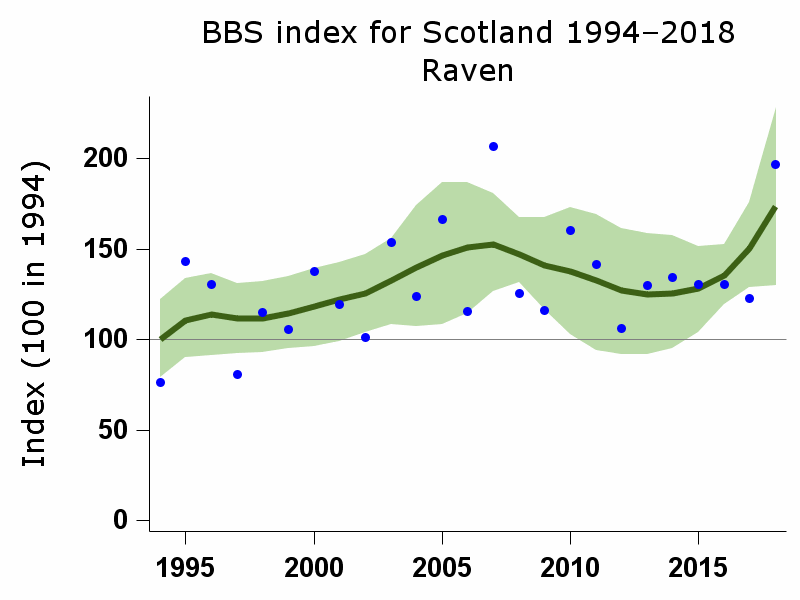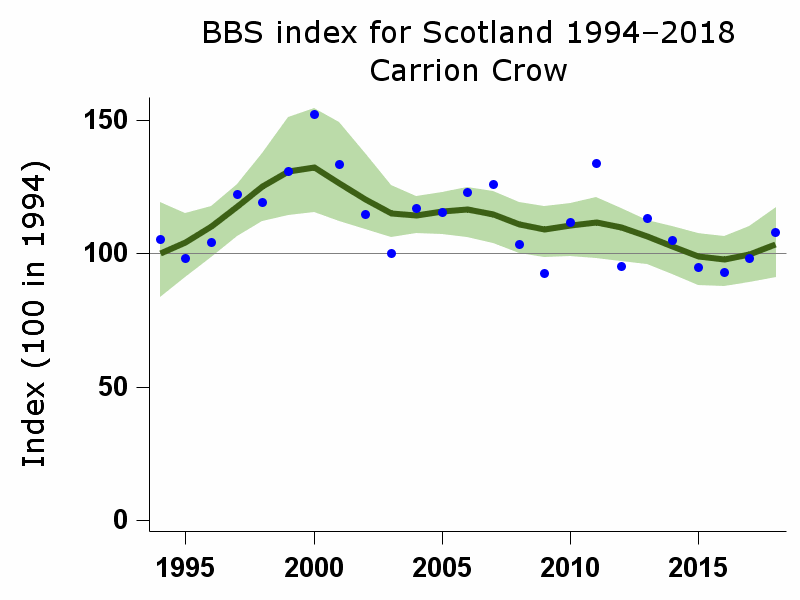
Magnus Linklater‘s piece in Monday’s The Times reminds me of many of his previous pieces (but we all believe in recycling) in that he always forgets to mention his close personal interest in game management and he always gets it a bit wrong in my humble opinion.
Where he is undoubtedly right is that farmland bird numbers, including Curlew (everyone loves the Curlew these days – funny how their numbers decline all the same), have plummetted over recent decades.
Linklater shoots himself in both feet when he deals with the real countryside from his New Town, Edinburgh point of view.
The Curlew used to be so numerous in Perthshire in the 1960s, he says, that it wasn’t worth counting, and now they are terribly rare. I can believe that.

Linklater, as usual thinks that predators are a large part of the problem, and not just for the Curlew but for everything else too. His three named important predators are: Red Fox, Hooded Crow and Raven. Quite why he doesn’t include Carrion Crow I really don’t know.
Two of these are birds, and let’s throw in the third bird, the Carrion Crow for completeness, and so we have pretty good Scotland-wide data on population changes, just as we have for Curlew. So here are Raven:

Carrion Crow:

And Hooded Crow:

Interesting. Ravens have certainly increased overall, although I challenge you to predict where the 2019 point will be from the last few years’ data! So, Linklater was right about that.
Carrion Crows are rather surprisingly stable in numbers – I was surprised. I wonder whether this would surprise Magnus Linklater too?
But the Hooded Crow is in decline a bit like the Curlew! Quite a bit like the Curlew actually. Almost as much as the Curlew actually. I didn’t know that until I checked, and I only checked because I have got into the habit of checking what Old Etonians say about the facts of life. My working hypothesis is that there are more glaring errors in the remarks and writing about nature, disease, ecology etc from the former pupils of this school than those of any other. It’s not always the case, but that’s why I check the facts before taking their word for anything…
If only there were a source of population data on Red Foxes in Scotland, then we could check that too. I expect there is one somewhere, do you know how to find it? It wouldn’t surprise me if Magnus Linklater were right about Red Foxes but at the moment he is right about Ravens (a bit) and completely and utterly wrong about Hooded Crows;
Anyone who lives in the country knows that there is now a huge imbalance between predators and prey. The sound of the curlew has long since been drowned out by the harsh call of the hooded crow and raven, whose numbers have soared.
Magnus Linklater https://www.thetimes.co.uk/article/mourn-the-birds-lost-to-unchecked-predators-trlwp7swv
As we have seen, the Hooded Crow has soared out of control in rather the same way taht the Curlew has! I look forward to Magnus Linklater’s column on saving the Hooded Crow…
Actually there is a source of data for Red Fox numbers but I wouldn’t claim that is is brilliant, and that is the BBS – yes the Breeding Bird Survey, where we volunteers collect data on mammals as well as birds.
Overall in the UK, Red Foxes:
Two mammals have declined significantly: Rabbit (62%) and Red Fox (42%). The drivers behind these declines are unknown.
https://www.bto.org/our-science/projects/bbs/latest-results/mammal-monitoring
You can have a look at the data in a bit more detail if you like, as I just have, because you can compare the UK trend for Red Fox with the England trend for Red Fox and find they are pretty similar (because England data will normally swamp Scotland data because England is a lot bigger than Scotland and also have more obervers per unit area). But my eyeballing of the data suggests to me that there is not much scope for a most remarkable difference between Scotland and the rest of the UK in Red Fox population trends given the overall BBS Red Fox trend. It’s not the greatest dataset but, having looked at it, I am all the keener to see some real data on Red Fox numbers – real numbers, not Linklater numbers, such as his Hooded Crow numbers.
There’s more to be said about this – laters!
[registration_form]
Raven, CC & HC do their habitats overlap? They presumably don’t eat the same things?
And a graph showing the intensification of silage cropping?
Circus – that’s what I’m looking for now!
Sounds to me that this wildlife shooter, Mr Linklater has never heard of sound science and operates pretty well from prejudice.
I think we can safely ignore his opinions
There are some studies of remnant Curlew populations, and indeed those of Lapwings which show that the problem predator of many nests is the Fox and some nests are also visited and eggs taken by Carrion Crows. However nearly all such studies have taken place at what one might call honey pot sites, where there are good numbers of these species in a relatively small area or a few pairs in good to marginal habitat. Honey pot sites by their very nature may well attract predation by crows /foxes from the surrounding poorer habitat (excessive numbers?) After all its what happened in Langholm 1 with Hen Harriers. It makes sense if you are such a predator with access to good numbers of potential prey to visit that area.
However back in the days before the recent declines there were huge areas with reasonable numbers of such ground nesting birds at MODERATE density so many nests escaped the eye or nose of the predator or habitats were better, less grazed or cut later or had lots of birds to mob off the predators. What we need to know as well as trying to protect the best sites (and make them bigger) is in part how to get back to that sort of situation.
There may have been a decline in crows and foxes but they are still very common. Here in Mid Wales where there are few waders and fewer suitable fields due to grazing pressure or early cutting dates Carrion Crows are very common indeed.
If we have a problem or problems we need to understand the whole of it and not just go for the gut reaction of “its a predation problem”, it may not be the root cause but if it is we still need to know what has changed for the preyed upon. What Linklater does is lazy journalism based on his anti predator prejudice and that should always be challenged and shown for what it is laziness or sometimes just plain wrong.
And don’t forget old Brer sheep loves munching on curlew eggs. And stomping around on the nests
Back in the late nineties, rather foolishly, i had the idea of introducing a few
Hooded Crow to Derbyshire, just for the hell of it really.
Unfortunately, the birds in Sligo ( where I was visiting a former colleague) laid early that year, and the local Carrion Crows were a bit late, so i was unable to find a host nest for the eggs i brought back, probably for the best i suppose.
The biology of the carrion crow/hooded crow interface is pretty well understood (better now than then, but still then) and your project would have certainly have failed. If you had understood the science (and IUCN guidance) you would not have attempted it. Did you perhaps make an omlette when you failed to find a host nest?
There had been a previous “interface” in the county some years previously, where hybridisation had occurred on two occasions.
Success would have further enraged my then headkeeper, which would have been a bonus.
But the hybrids, though fertile, would not have been successful in attracting mates. That’s why there’s a pretty firm boundary and the species don’t re-merge.